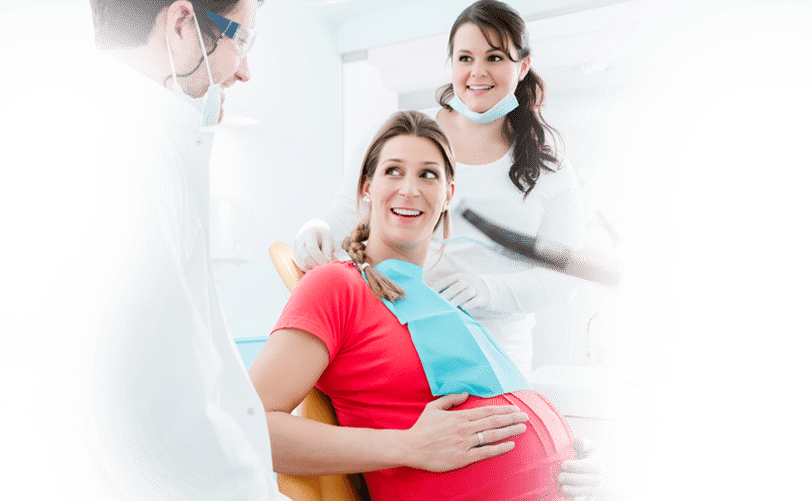
The body goes through many changes during pregnancy. Hormonal changes are often accompanied by an elevated tendency for gingivitis and a worsening of existing dental problems. Gingivitis will manifest as bleeding from the gums during brushing or use of dental floss, accompanied by sensitive gums.
 It is important to note that the bacterial composition found in the mother’s mouth will determine the bacterial composition that the baby will develop after birth, meaning that bacteria that can cause caries or gum disease will be transmitted to the baby and will determine the health of their teeth for the rest of their life.
It is important to note that the bacterial composition found in the mother’s mouth will determine the bacterial composition that the baby will develop after birth, meaning that bacteria that can cause caries or gum disease will be transmitted to the baby and will determine the health of their teeth for the rest of their life.
Amalgam and mercury in pregnant women
Studies have shown a correlation between mercury levels in the umbilical cord and the number of amalgam fillings in a mother’s mouth, and several studies have shown a link between mercury transfer to the fetus and autism, as well as other developmental problems in newborn babies.
If immediate action is required for a tooth with an amalgam filling (due to a broken tooth, pain, etc.) – it is imperative to perform such treatment in a clinic that practices safe amalgam removal while using special equipment, in order to prevent harmful fetal exposure to mercury. We also recommend postponing elective treatments until after birth and breastfeeding.
What is recommended during pregnancy?
In order to prevent gingivitis, it is recommended maintain regular visits to the dental hygienist for teeth cleaning and plaque removal (every three months – if necessary), and to keep a meticulous brushing and flossing routine. It is also recommended to consult a dentist during periodic check-ups and integrate the use of various hygiene products (toothpaste, mouthwash) that can help during this time.
In addition, in order to minimize the transfer of bacteria responsible for caries to the baby after birth, the use of gum and candies containing a sugar substitute called XYLITOL is recommended. Xylitol is safe to use during pregnancy and breastfeeding, and significantly inhibits the development of harmful bacteria in the mother’s mouth, thereby eliminating the risk of transfer of these bacteria to the baby, hence supporting the development of healthier composition of bacteria in the baby’s mouth. For this reason, it is recommended for use especially during the third trimester and during breastfeeding.
For more information on Xylitol: http://www.proxylitol.com/
X-rays during pregnancy
Routine X-rays are not performed during pregnancy, however when emergency treatment is necessary and an X-ray is required for diagnosis, the minimum number of X-rays required for the treatment is performed, and a radiation-blocking apron is used to reduce X-ray exposure for you and your fetus.

Scientific Articles On This Subject
Hasegawa K et al Associations between systemic status, periodontal status, serum cytokine levels, and delivery outcomes in pregnant women with a diagnosis of threatened premature labor. Journal of Periodontology December 2003, Vol. 74, No. 12, Pages 1764-1770
Klinger A1, Hain B, Yaffe H, Schonberger O. Periodontal status of males attending an in vitro fertilization clinic. J Clin Periodontol. 2011 Jun;38(6):542-6. doi: 10.1111/j.1600-051X.2011.01720.x. Epub 2011 Mar 28.
Nwhator SO1, Umeizudike KA2, Ayanbadejo PO3, Opeodu OI4, Olamijulo JA5, Sorsa T6. Another reason for impeccable oral hygiene: oral hygiene-sperm count link. J Contemp Dent Pract. 2014 May 1;15(3):352-8
Nwhator S1, Opeodu O2, Ayanbadejo P3 et al. Could periodontitis affect time to conception? Ann Med Health Sci Res. 2014 Sep;4(5):817-22. doi: 10.4103/2141-9248.141567.
Armitage GC. Bi-directional relationship between pregnancy and periodontal disease. Periodontol 2000. 2013 Feb;61(1):160-76.
Palkovicova L1, Ursinyova M, Masanova V, Yu Z, Hertz-Picciotto I. Maternal amalgam dental fillings as the source of mercury exposure in developing fetus and newborn. J Expo Sci Environ Epidemiol. 2008 May;18(3):326-31. Epub 2007 Sep 12.
